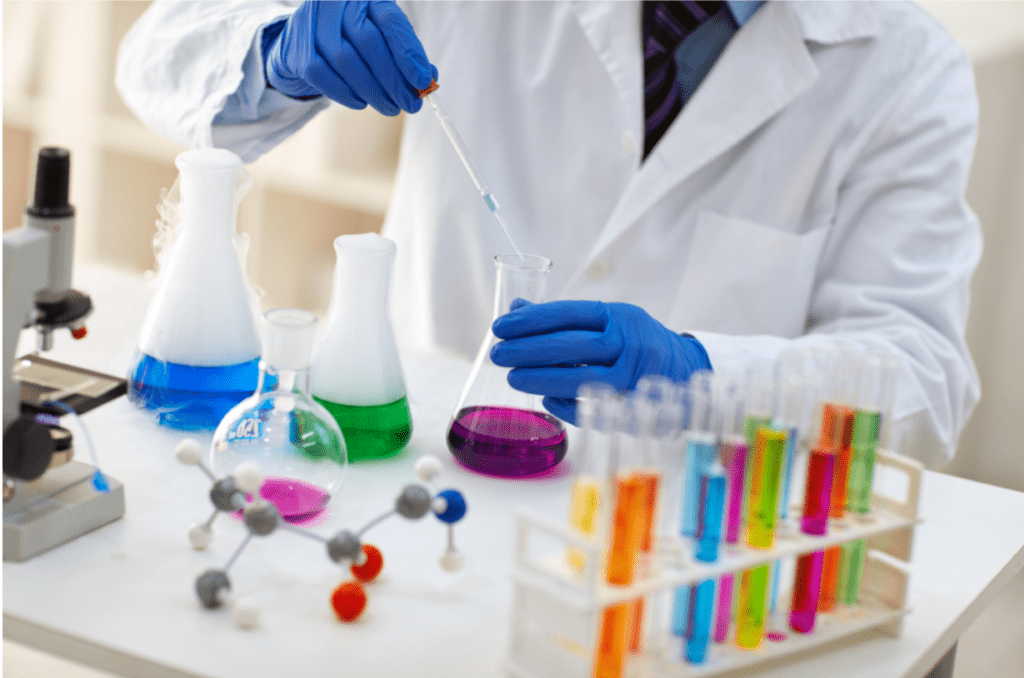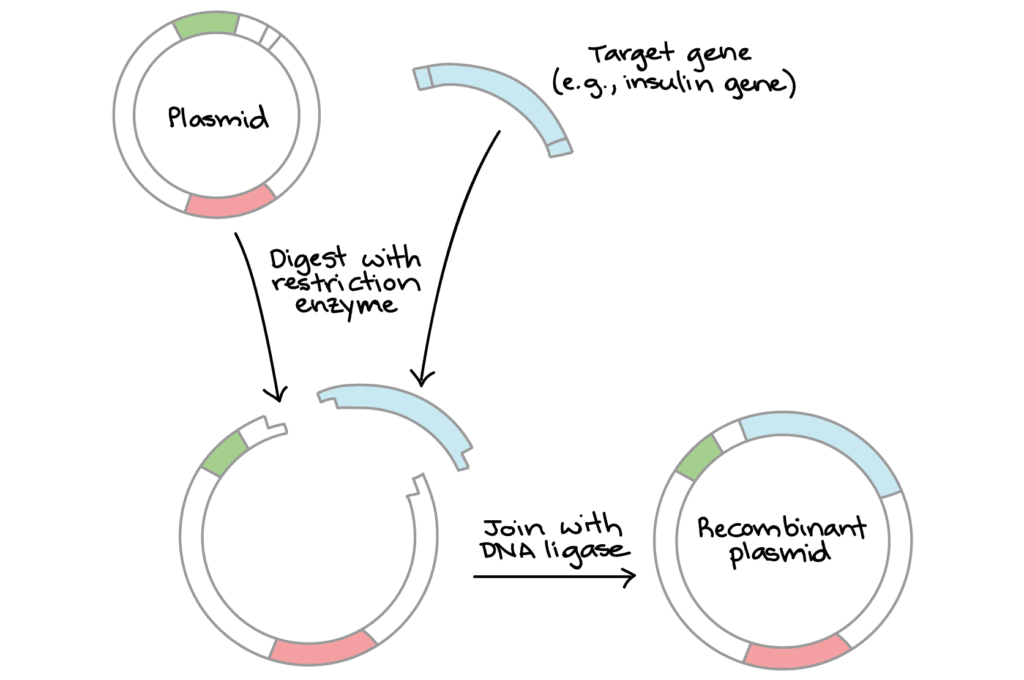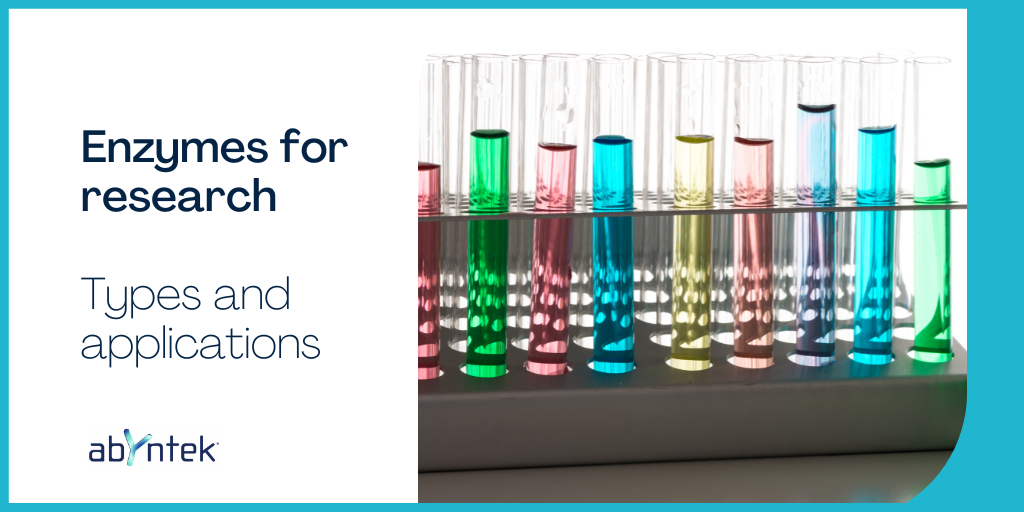Enzymes are organic molecules that act as catalysts for chemical reactions.
Due to its functional diversity, they are one of the most widely used biomolecules in scientific research laboratories.
These catalytic proteins play a fundamental role in areas as diverse as the manufacture of detergents, the synthesis of new drugs, or various analytical tests with clinical, forensic or environmental applications.
In this post, we bring you a summary of the types and applications of enzymes for research.
With +7 million references in our catalog and the capacity to develop customized reagents, ABYNTEK BIOPHARMA offers you a wide range of enzymes for scientific research.
Contact us and we will advise you on the reagent that best suits your project.

TYPES OF ENZYMES FOR RESEARCH
Although enzymes for research can be classified according to different criteria such as their origin (bacterial, animal, vegetable, etc.) or the application in which they are going to be used, the most relevant classification is the one based on the type of reaction they catalyze.
According to this last criterion, we find 6 types of enzymes:
1.- Oxidoreductases
Are the enzymes that catalyze oxidation-reduction reactions. Within this category are , among others, dehydrogenases, oxidases and peroxidases.
2.- Transferases
Transfer a functional group (for example, a methyl or a phosphate group) from one compound to another. As examples we have phosphotransferases, methyltransferases or kinases.
3.- Hydrolases
They catalyze the hydrolytic cleavage of C-O, C-N, C-C bonds, among others. This group includes, for example, proteases or phosphatases.
4.- Liases
Are the enzymes responsible for the reactions of breaking and forming double bonds. They catalyze the addition of ammonia, water, or carbon dioxide to double bonds, or they remove them to form double bonds. As an example, we have aldolases or synthases.
5.- Isomerases
They catalyze the transfer of groups within a molecule giving rise to isomeric forms of the substrate. As an example, we can cite mutases.
6.- Ligases
They catalyze the union of two substrates. As an example, carboxylases or synthetases.
APplications of enzymes for research
Research enzymes are increasingly being used to replace the use of chemicals or processes that pose environmental or safety concerns. This is because, on the one hand, they allow processes that use aggressive chemical substances to be replaced by milder, non-toxic enzymatic processes and, on the other, because the biotechnological process of enzyme production itself has a minimal environmental impact.
Among the fields with the most important applications of enzymes for research are:
ANALYSIS REAGENTS
Enzymes have a wide variety of analytical applications due to their ability to detect and amplify a specific analyte:
Enzymatic assays for detection and quantification
In these assays, an enzyme is used to measure other compounds. As an example of this we have catalase.
Catalase is an antioxidant enzyme that catalyses the breakdown of hydrogen peroxide (H2 o2) into water and oxygen. We can see the reaction in the following image:

This enzyme is widely found in aerobic cells that contain cytochrome systems. Detection kits using this enzyme use the peroxidase function of catalase to measure catalase activity. In the presence of a suitable concentration of H2 o2, catalase reacts with methanol and produces formaldehyde, this compound reacts with chromogens. Chromogens produce colour that can be measured by absorbance at 540 nm.
Immunodiagnostic assays
Immunodiagnostic tests are tests that use the avidity of antigen-antibody binding to identify and measure the presence of certain analytes in samples. The best known and used immunoassay is the ELISA test.
In ELISA technique enzymes are used to covalently label the detection antibodies. Through the enzyme reaction, the binding of the antibody to the antigen of interest is visualized. The most commonly used enzyme in this type of immunoassay is horseradish peroxidase or HRP.

HRP is an enzyme with a high catalytic activity, which makes it possible to detect even very small concentrations of analyte. When adding the TMB substrate to the ELISA well, the HRP enzyme degrades it, transforming it into a diimine that generates a colour change in the medium, as shown in the image:

This colour change can be measured by absorbance at 450 nm and thus calculate the concentration of antigen in the sample.
On the other hand, there are also ELISA tests, which reveal the antigen-antibody avidity for the detection of analytes using chemiluminescence reactions instead of colorimetric ones. These are called CLIA tests.
They have the same basis as the ELISA technique, but the difference is that the detection mechanism is a chemiluminescent reaction that results in the emission of photons producing light instead of producing a colour change. Detection by chemiluminescence makes this technique more sensitive than conventional ELISA. In a CLIA test, the acridinium ester requires the presence of H2O2 as an oxidizing agent and NaOH to produce a pH change that allows oxidation to occur, as seen in the image. Through this reaction, the final compound is obtained, which is what causes the light that is subsequently measured.

Unlike the ELISA test, the CLIA is not based on the use of an enzyme such as HRP.
INDUSTRIAL CATALYSTS
Enzymes are also used in different industrial processes in order to facilitate production or improve the product resulting from a certain process, among others.
The industrial applications of enzymes can be seen in the following table:
| TYPE OF INDUSTRY | PROCESS | EXAMPLES |
| Food industry | To process carbohydrates, proteins and fats | Amylases, lactases pectinases, lipases, etc. |
| Leather | To remove hair and traces of protein and fat that may remain in the fabric. | Proteases Lipases |
| Textile industry | To give fabrics a softer appearance. To remove hydrogen peroxide residues after a bleaching process. | Cellulases Catalases |
| Detergents and washing agents | To remove stains on clothes. | Proteases, lipases, Amylases |
| Cosmetic industry | To neutralize reactive oxygen species produced by ultraviolet radiation. To hydrolyze triglyceride molecules for facial and hair hygiene products. To break the peptide bonds of proteins for anti-stretch mark, exfoliating and hair removal products | Superoxide dismutase Lipases Proteases |
| Pharmaceutical industry | To obtain drug precursors. For semi-synthesis of drugs from natural substances. For the enzymatic resolution of racemic mixtures. | Hydrolases, Liases and oxidoreductases |
| Environmental industry | For environmental decontamination. To produce biofuels. To synthesize bioplastics. | Laccases Amylases, glucoamylases and pullulanases Depolymerases |
MoLECULAR BIOLOGY
Within the field of molecular biology, enzymes are the basis of many of its processes or techniques.
Here we describe the most commonly used:
Polymerases
They are used to perform the PCR technique. PCR (Polymerase chain reaction) is used to amplify and make many copies of a certain region of DNA in vitro.
Specifically, in order to perform this technique, we require the presence of the Taq polymerase enzyme. It´s function in PCR is to produce new DNA strands from a DNA template. In order to give rise to DNA copies, Taq polymerase requires the presence of primers, which extend from one end to the other.

Nucleases
They are proteins or enzymes capable of breaking the bonds between nucleotides, thus breaking the DNA or RNA molecule. These types of enzymes, such as, RNAses, DNAses, or proteases, are used in molecular processes for the extraction of nucleic acids or proteins to eliminate unwanted components.
They also have other uses, such as Cas proteins. These Cas proteins (CRISPR associated protein) are endonucleases known to act as “molecular scissors”, cutting and editing or correcting the target DNA. They are used in the CRISPR technique, and the best known and studied in is the Cas9 protein.

Restriction enzymes
They are found in bacteria and other prokaryotes. Its mission is to recognize specific DNA sequences (called restriction sites) and bind to them. Each enzyme recognizes only a few restriction sites. When it finds the target sequence, the restriction enzyme cuts the 2 strands of a DNA molecule. Normally, the cut occurs close to the restriction site and follows and orderly and predictable pattern. These types of enzymes are used in cloning processes.
DNA ligase
If two DNA fragments have complementary ends, the ligase enzyme is able to join them, thus ligating them into a single molecule. This enzyme is used in conjunction with restriction enzymes in DNA cloning to insert genes and other DNA fragments into cloning vectors.

Do you want to know more about enzymes for research?
Contact us and we will answer all your questions.
Our team will help you find the enzyme you need to ensure a successful research project.




